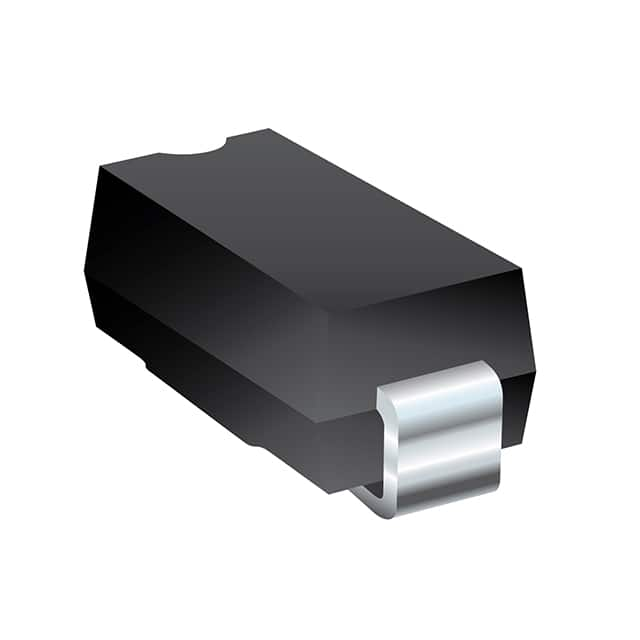Consulte las especificaciones para obtener detalles del producto.

SMLJ6.0A Diode - Encyclopedia Entry
Introduction
The SMLJ6.0A diode is a crucial component in electronic circuits, belonging to the category of transient voltage suppressor (TVS) diodes. This entry provides an overview of the SMLJ6.0A diode, including its basic information, specifications, pin configuration, functional features, advantages and disadvantages, working principles, application field plans, and alternative models.
Basic Information Overview
- Category: Transient Voltage Suppressor (TVS) Diode
- Use: Protection against voltage transients in electronic circuits
- Characteristics: Fast response time, low clamping voltage, high surge current capability
- Package: DO-214AB (SMC), SMA package
- Essence: Provides protection by diverting excessive current away from sensitive components
- Packaging/Quantity: Available in tape and reel packaging, with quantities varying based on supplier
Specifications
- Peak Pulse Power: 6000W
- Breakdown Voltage: 6.0V
- Operating Temperature Range: -55°C to +150°C
- Storage Temperature Range: -55°C to +150°C
- RoHS Compliant: Yes
Detailed Pin Configuration
The SMLJ6.0A diode has a standard DO-214AB (SMC) or SMA package with two leads. The anode is connected to the positive terminal, while the cathode is connected to the negative terminal.
Functional Features
- Transient Voltage Suppression: Rapidly clamps transient voltages to safe levels
- Low Clamping Voltage: Provides effective protection for sensitive electronic components
- Fast Response Time: Reacts quickly to transient voltage spikes
Advantages and Disadvantages
Advantages
- Effective protection against voltage transients
- Fast response time
- Low clamping voltage
Disadvantages
- Limited to specific voltage ratings
- May require additional circuitry for comprehensive protection in complex systems
Working Principles
When a transient voltage spike occurs, the SMLJ6.0A diode conducts and diverts excess current away from the protected circuit, limiting the voltage to a safe level.
Detailed Application Field Plans
The SMLJ6.0A diode finds extensive use in various applications, including: - Power supply units - Telecommunication equipment - Automotive electronics - Industrial control systems - Consumer electronics
Detailed and Complete Alternative Models
- Alternative Model 1: P6SMB6.0A
- Alternative Model 2: 1.5SMC6.0A
- Alternative Model 3: SMBJ6.0A
- Alternative Model 4: 5KP6.0A
In conclusion, the SMLJ6.0A diode serves as a critical component in protecting electronic circuits from voltage transients, offering fast response times and low clamping voltages. Its application spans across various industries, making it an essential part of modern electronic systems.
Word Count: 411
Enumere 10 preguntas y respuestas comunes relacionadas con la aplicación de SMLJ6.0A en soluciones técnicas
What is SMLJ6.0A and what is its application in technical solutions?
- SMLJ6.0A is a transient voltage suppressor diode used to protect sensitive electronic components from voltage spikes and transients in technical solutions.
How does SMLJ6.0A provide protection in technical solutions?
- SMLJ6.0A clamps the voltage during transient events, diverting excess current away from sensitive components and preventing damage.
What are the key specifications of SMLJ6.0A relevant to technical solutions?
- The key specifications include its breakdown voltage, peak pulse power, maximum clamping voltage, and response time.
In what types of technical solutions is SMLJ6.0A commonly used?
- SMLJ6.0A is commonly used in power supplies, communication equipment, automotive electronics, and industrial control systems.
What are the typical failure modes of SMLJ6.0A in technical solutions?
- The typical failure modes include degradation due to prolonged exposure to high voltage transients and thermal overstress.
How can SMLJ6.0A be integrated into a technical solution for optimal performance?
- SMLJ6.0A should be placed as close as possible to the protected components and properly grounded for effective transient suppression.
What are the industry standards or certifications relevant to the use of SMLJ6.0A in technical solutions?
- SMLJ6.0A may comply with industry standards such as IEC 61000-4-5 for surge immunity and RoHS compliance for environmental regulations.
Are there any recommended best practices for testing and validating the effectiveness of SMLJ6.0A in technical solutions?
- Best practices include conducting surge tests, transient voltage suppression tests, and thermal performance tests to ensure proper functionality.
What are the potential alternatives to SMLJ6.0A for transient voltage suppression in technical solutions?
- Alternatives may include other transient voltage suppressor diodes with similar or improved specifications, or more advanced protection devices like metal oxide varistors (MOVs).
How can SMLJ6.0A contribute to the overall reliability and longevity of technical solutions?
- By effectively suppressing voltage transients, SMLJ6.0A helps prevent premature component failure and ensures the reliability and longevity of the technical solution.

